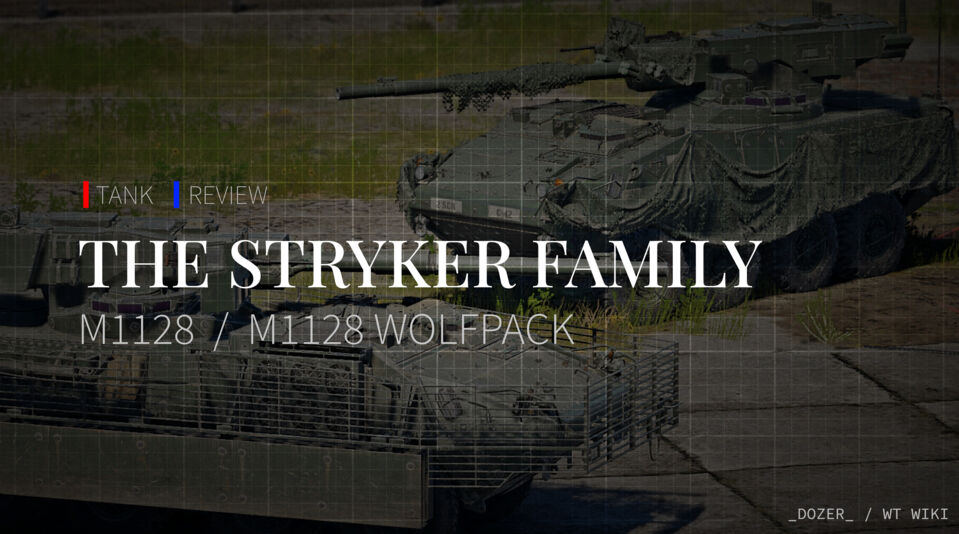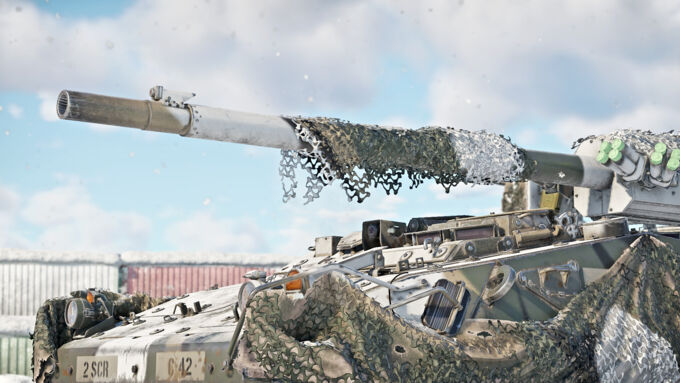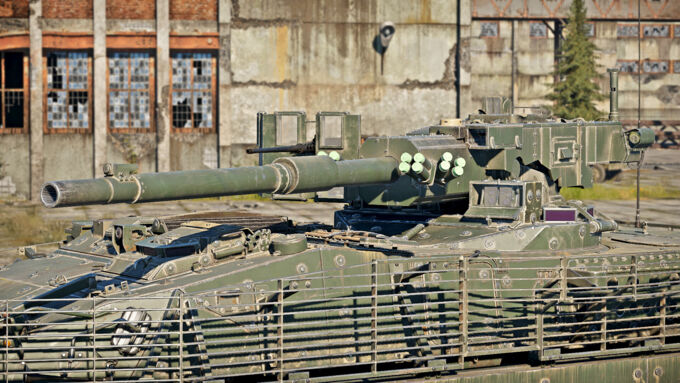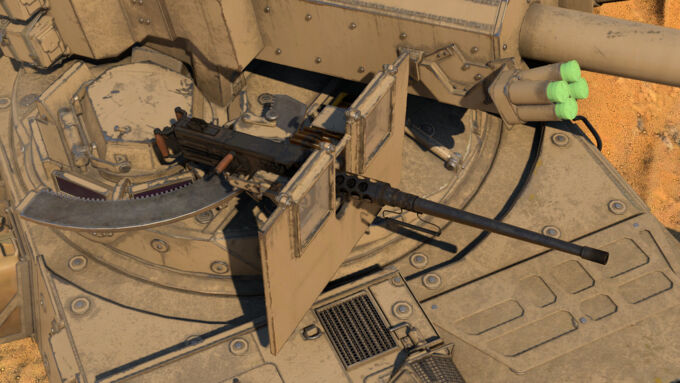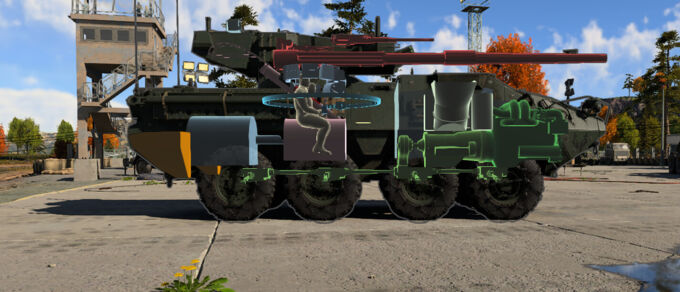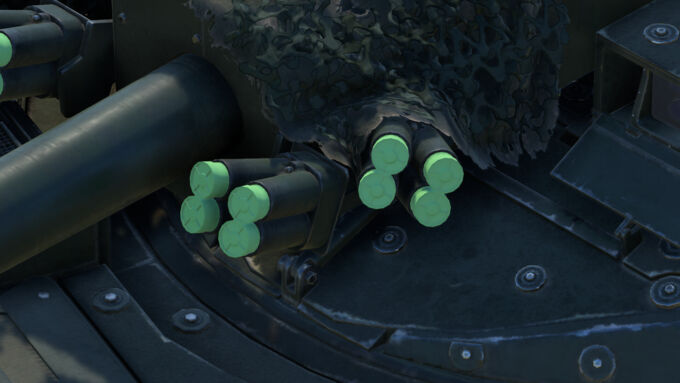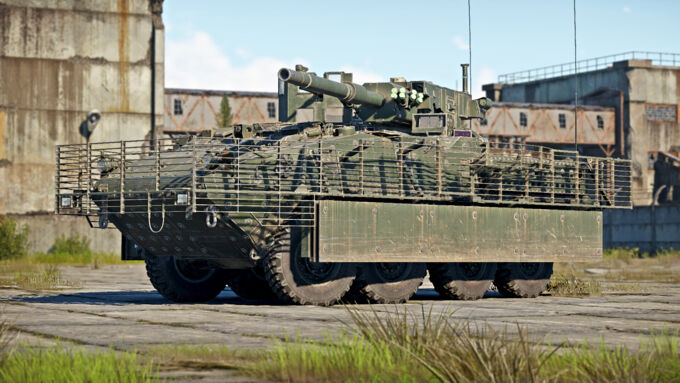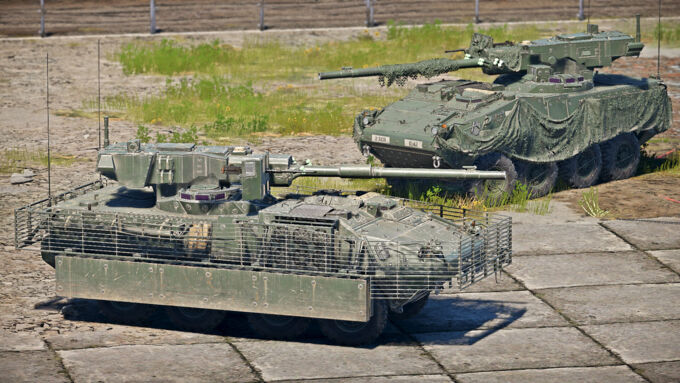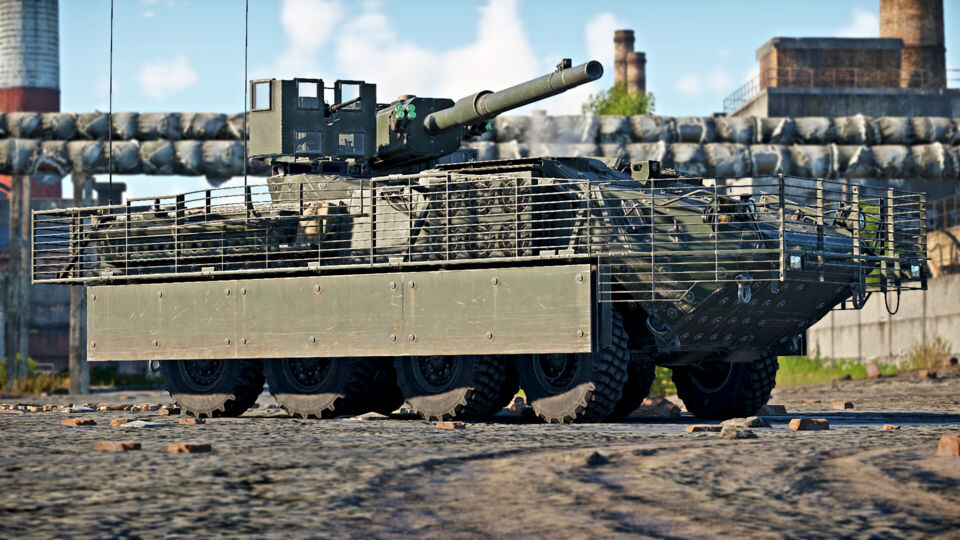The M1128 Stryker is the heavy hitter of the Stryker family, built to take on enemy tanks from long range effectively. Built on an 8×8 wheeled chassis, it trades heavy protection for high mobility and long‑range firepower. An unmanned 105 mm turret, complete with two‑plane stabilisation and a 8‑round autoloader, lets the M1128 engage targets on the fly both effectively and safely. The Wolfpack premium variant shares identical performance to the tech tree Stryker, but swaps the add-on slat armour for a camouflage net and premium economic bonuses.
| High Mobility: 96 km/h top speed and a P-W ratio of 18.7HP/ t enables fast repositioning and flank runs. | Thin armor; Highly vulnerable to air/artillery strikes |
| Survivable when hull down; has an unmanned turret with a small profile | Limited gun angles; Poor gun depression of only –5° |
| Great Firepower; Has few issues penetrating targets | Low ammo count; 8 rounds in the autoloader and 18 total limit long duration engagements |
| Gen 3 Thermals; Clear, high-definition/contrast view of the battlefield | Mediocre reverse of 12km/h; Relatively low HP/t of 18.7 compared to peers |
Armaments
105 mm M68A1E8 Cannon
At the heart of every M1128 is the American‑built, two‑plane stabilised 105 mm M68A1E8 cannon, mounted in an unmanned turret above the hull. An 8‑round autoloader feeds the gun every 7.5 seconds (6.5 s with an ace crew), letting you fire quickly with no worries of turret crew incapacitation. The gun’s elevation spans between –5° to +15°, and the turret slews at up to 40 °/s with ace gunner skills.
Available Ammunition
| Shell Type | Use Case | Verdict |
|---|---|---|
| M900 APFSDS | Primary round, excels at defeating MBTs and light armor alike with high penetration and reliable spalling. | Always carry as your main round. Consistent, fast, and deadly. |
| M774 APFSDS | Outdated round with significantly lower penetration. Noticeably less consistent than M900 in every way. | Not recommended. Strictly inferior to M900 in all relevant metrics. |
| M456A2 HEATFS | HEAT-FS round. Lacks consistency and suffers from low velocity/inability to do much against composites and ERA found commonly at the tier. | Situational at best, avoid unless you are intentionally limiting yourself. |
The M1128 is a pure kinetic sniper and your shell choice should reflect that. Your primary and overwhelmingly most effective round is the M900 APFSDS. It offers a high muzzle velocity, excellent penetration and reliable post-penetration spalling, making it the best option against everything from MBTs to IFVs and even low-flying helicopters.
You might notice the M774 APFSDS and M456A2 HEATFS shells are alternative options, but these are largely legacy options. M774 is simply a worse M900 in every metric that matters. Less penetration, a lighter shell mass and weaker post-penetration effects make it strictly inferior to M900 in almost every meaningful way. HEATFS, while technically useful against thin-skinned vehicles, is too inconsistent, slow, and situational to justify carrying, especially at top-tier where APFSDS dominates. This is exacerbated by the fact that the M1128 only has a 8-round ready rack and a 18-round total rack to play with; in almost every situation a second M900 shell will finish the job the first shell started, and pre-loading M456A2 just to deal with the possibility of seeing light tanks limits your engagement options against other, more heavily armored vehicles.
Unless you’re intentionally limiting yourself, there is no good reason to have anything other than M900 rounds in your vehicle.
Secondary Armaments
.50 cal M2HB Coaxial MG: Mounted alongside the main gun, this heavy machine gun carries 400 rounds (100‑round belts) in total. It’s perfect for helicopters or finishing off light tanks/exposed crew.
7.62 mm M240 MG: Hull‑mounted coaxial belt gun. Tracer fire helps mark enemies for allies or finding targets through smoke.
Armor & Survivability
The M1128’s “armor” is very thin, relying on 12mm thick steel plating for both the hull and turret. Unlike main battle tanks, the Stryker trades most of its passive protection for good positioning, achieved through good mobility. Its unmanned turret prevents direct crew casualties from turret penetrations, but any hits to the hull by 12.7mm and larger shells will easily penetrate and damage the vehicle. Crew safety thus depends on staying behind cover to expose only the turret, using smoke, and leveraging reconnaissance rather than armor effectiveness.
Armor Effectiveness
| Front | Side | Rear | |
|---|---|---|---|
| Hull | 12 mm | 12 mm | 12 mm |
| Turret | 12 mm | 12 mm | 12 mm |
Despite its negligible plating, the Stryker’s unmanned turret design means turret-only hits rarely injure crew directly. Lethal ammunition stowage resides in the hull floor, so a penetrating shot risks catastrophic cook-off.
To bolster battlefield survivability, the M1128 is equipped with:
| Smoke Grenade Launchers: | Rapid smoke screen for cover and retreat. |
| Scout UAV: | Provides real-time spotting and overwatch to avoid exposure. |
| Slat Armor (Tech Tree only): | Adds an additional layer of protection against chemical rounds, but makes the Stryker heavier and easier to spot. |
| Camouflage Net (Premium only): | Adds camouflage netting on the sides and other parts; Cosmetic only, adds no actual protection. |
It is also to be noted that due to the limited gun depression of –5°, the M1128 cannot make usage of certain terrain features other NATO vehicles can utilize. Always keep this in mind when trying to ambush someone — you may need to adopt a Soviet mentality for positioning this tank hunter!
Armor Comparison
Compared to similar wheeled light tanks of its tier (e.g. Type 16, Centauro, Vextra 105, Rooikat etc.), the M1128’s protection is mostly standard for an armored car: negligible armor compensated by situational awareness and high mobility.
Premium Variant Upgrades
While the base M1128 relies purely on its steel plating and optional Slat Armor, the Wolfpack premium version trades the slat armor for a camouflage net and premium rewards:
- Camouflage Netting: Slightly reduces visual detectability. Only works when near foilage, or shadows, does not affect thermal vision!
- Premium Rewards: Gives increased SL and RP rewards as well as being able to research tanks from tiers 1 through 8 without the research penalty found on tech tree vehicles.
These non-armor upgrades don’t stop any rounds, but they make the Wolfpack just that little bit more unique.
Mobility
The M1128 Stryker harnesses a 350 hp diesel engine to propel its 18.7-ton chassis, yielding a 18.7 hp/t power-to-weight ratio. It can sprint to 96 km/h on roads and manage 12 km/h in reverse, which is respectable for a wheeled tank hunter, but its rapid-fire doctrine depends on straight-line speed rather than off-road agility.
The acceleration feels great on pavement, yet the heavy autoloader turret can restrict sharp maneuvers in rough terrain and can sometimes result in you spinning out if not careful. Once you commit to a flank or hull-down position, quick course changes can often take a protracted amount of time, and the (relatively) middling reverse speed means you cannot simply back out of danger just as fast as you drove in. The lack of neutral steering compounds this matter, so good positioning and gamesense is paramount.
Mobility Comparison
Compared to similar 8×8 light tanks such as the Type 16, Centauro, Vextra 105 and Rooikat, the M1128’s top speed is decent, letting it get into position or dash for cover quite quickly. However, its slow reverse and heavier turret lessen the effectiveness of hit-and-run tactics compared to lighter scout vehicles. In essence, the Stryker excels at decisive dashes into crucial points and then holding ground, rather than weaving constantly under fire. It thrives when used to strike swiftly with other heavier tanks. Use smoke, and relocate rather than attempting continuous fights in close environments.
It is also to be noted that the Stryker’s HP/t of 18.7 is below average for a light vehicle; while good, other wheeled vehicles of this BR often manage near or above 20HP/t (the Vextra has 25!), so the Stryker may not be the first vehicle to hit the flanks, so to speak. Utilizing the unmanned, low profile turret to your advantage to counter these threats will be a priority for any aspiring M1128 players.
Usage in Battle
The Stryker excels when used as a rapid-support hunter, not a frontline brawler. Leverage its high road speed to get into positions ahead of your team, then use the Scout UAV to scout enemies. Once you’ve seen or marked an enemy, fire away with the 105 mm cannon and then immediately get behind some cover or retreat.
Smoke grenades are your lifeline, use smoke as soon as enemy tanks spot you, obscuring your retreat path. With reverse limited to just 12 km/h, you can’t simply back away like a tracked tank, you must flee under cover or loop back along roads. The dual-control system means if your driver is knocked out, the commander can maintain mobility, keeping you alive long enough to fall back.
On open-field maps, use roads and cover to move swiftly into hull-down positions on dunes or hills. From there, your 96 km/h top speed becomes a threat: you can strike enemy armor at range and then get back behind terrain. Keep to the flanks and never face heavier tanks head-on.
In the hands of a patient player, the M1128 becomes a surgical strike platform—visible only for a moment before vanishing under a wall of smoke. Play to its strengths of speed, recon, and rapid-fire ambushes, and you can turn its fragile armor into a tactical advantage on the battlefield.
Credits
Credits to Keebird for the images marked with * and the image in the thumbnail and to nornfang58 for the thumbnail.
This article would not be possible at all without their help so massive thanks🙏.
